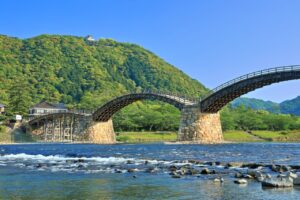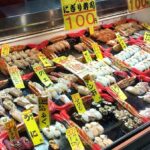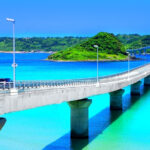Contents
Kintai Bridge in Iwakuni City, Yamaguchi Prefecture, is one of Japan’s most celebrated historic bridges and a masterpiece of traditional wooden architecture. Known for its elegant sequence of five wooden arches stretching across the Nishiki River, the bridge attracts visitors from around the world for its beauty, craftsmanship, and the dramatic scenery that surrounds it in every season.
Overview
Built in 1673, Kintai Bridge was originally designed as part of the entrance to Iwakuni Castle, which sits atop Mount Shiroyama. The bridge was engineered to withstand frequent flooding, a major challenge at the time, and has become world-renowned for its structural ingenuity. Although it has undergone repairs and reconstructions, each restoration has remained faithful to the original techniques and aesthetic, preserving its historical authenticity.
Today, Kintai Bridge is a designated National Treasure of Japan and serves as the centerpiece of the scenic Kintai Park area, which includes landscaped gardens, museums, historical residences, and the cable car leading to Iwakuni Castle.
Architectural Features
1. Five Wooden Arches

The most distinctive feature is the unique series of five consecutive arch spans:
-
Constructed using traditional timber techniques
-
Supported by granite piers
-
Joined through an intricate system of wooden joints without metal nails
This design allows the bridge to flex naturally and withstand environmental changes.
2. Craftsmanship and Technique

The construction showcases:
-
Precision joinery
-
Interlocking wooden components
-
A layered arch structure designed for both strength and beauty
Master carpenters still maintain the bridge through periodic reconstructions using traditional methods.
Seasonal Scenery
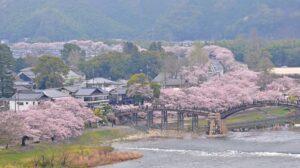
Kintai Bridge offers spectacular views year-round:
Spring
Cherry blossoms in Kintai Park create one of Japan’s most famous sakura landscapes. The bridge becomes surrounded by pink blooms and is illuminated at night during the cherry blossom festival.
Summer
Lush greenery and clear river reflections create peaceful scenery. The nearby cormorant fishing (ukai) performances on the Nishiki River add cultural interest.
Autumn
The banks of the river turn vivid shades of red and gold. Cooler weather and clear skies make this an excellent season for photography.
Winter
Light snow occasionally dusts the arches, creating a quiet, picturesque atmosphere.
Nearby Attractions
1. Iwakuni Castle

Accessible via a short cable car ride from Kintai Park, the castle offers:
-
A museum displaying samurai armor and artifacts
-
Observation decks with panoramic views of Iwakuni and the Seto Inland Sea
2. Kikkawa Residence and Historical District
Historic samurai residences, traditional gardens, and old merchant streets provide insight into the lifestyle of the ruling Kikkawa clan.
3. White Snake Museum
Iwakuni is known for its rare white snakes, considered symbols of good fortune. The museum explains their biology and cultural significance.
4. Kintai Park (Kikko Park)
A beautifully landscaped park with ponds, seasonal flowers, historical buildings, teahouses, and shaded walking paths.
5. Sakigake-no-Sato Ropeway Station Area
A small shopping and dining area offering local specialties such as lotus root dishes and Iwakuni sushi.
What to Do
1. Walk Across the Bridge
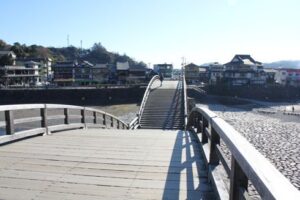
The gentle slope of each arch provides alternating high and low perspectives of the river and castle.
2. Enjoy a River Cruise
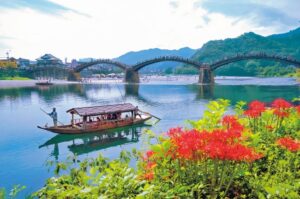
Seasonal boat rides offer unique views from beneath the arches.
3. Visit During Festivals
Notable events include:
-
Spring Cherry Blossom Festival
-
Summer Cormorant Fishing
-
Kintai Bridge Festival with samurai parades and traditional performances
4. Photography
The bridge is especially photogenic at sunrise and sunset, as well as during nighttime illuminations.
Practical Information
Location
Iwakuni City, Yamaguchi Prefecture
Approximately 40–50 minutes by train or car from Hiroshima City.
Access
-
From JR Iwakuni Station: 20 minutes by bus
-
From Shin-Iwakuni Station (Shinkansen): 10 minutes by taxi or bus
Well-signposted for international travelers.
Hours & Fees
The bridge can be crossed during the day by purchasing a small admission ticket. Combined tickets are available for:
-
Bridge crossing
-
Ropeway to Iwakuni Castle
-
Castle museum entrance
Facilities
-
Rest areas and shaded seating
-
Souvenir shops featuring local crafts
-
Cafés and restaurants near Kintai Park
-
English signs available throughout the area
Recommended Duration
1.5 to 3 hours, depending on whether you visit Iwakuni Castle and surrounding attractions.
Local Cuisine to Try Nearby
-
Iwakuni Sushi: A layered, pressed sushi unique to the region
-
Lotus Root Dishes: A local specialty used in stews, tempura, and side dishes
-
Matcha sweets and traditional Japanese confections in Kikko Park teahouses
Why You Should Visit
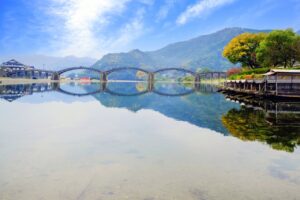
Kintai Bridge offers a rare combination of historic architecture, natural beauty, and cultural depth. It is a place where traditional craftsmanship meets timeless landscapes. Whether you explore the bridge itself, stroll through the gardens, or ascend to the castle with panoramic views, the area delivers an unforgettable experience that highlights the elegance and ingenuity of Japanese heritage.
Related articles
Official Website
https://kintaikyo.iwakuni-city.net/en/
Great Accommodation Site
